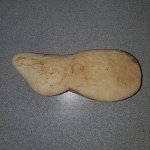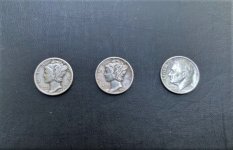george77
Greenie
I've seen folks doing one or some of each of these three things. But I've got a little routine now that's a combination of all three and then some.
It's a little intensive on the learning curve and requires some moderately advanced computer skills. But the potential savings in gas money alone justifies this type of searching, in my opinion.
I've only just begun, mind you. So, I've got nothing to show for it yet...except enthusiasm
Here's what I did while I was recovering from a hernia operation last month:
First, I located my county's tax database and downloaded it--the whole thing. I filtered out all but the addresses that have a "year built" field listed. So, now I've got about 50,000 addresses which all have a year attached. I also kept the street address and owner's name. So now, on my computer I can pull up a list of all the addresses in my county that fall into some criteria I choose, say, anything before 1750, or those between 1850 and 1964 on Market Street. This is something I could not easily do while searching the database online. If I'm looking for old coins, I don't want to have to sift through address listings with modern dates.
Then, when I find some interesting addresses and dates, I toggle over to Google Maps or Google Earth and see what it looks like from above...Is there land nearby? Other houses? And of course you can be sure to get directions while you're at it. Google allows you to mark each place of interest, making notes and saving it as you go along.
Two other valuable tools are United States Geological Survey Maps, historical ones, in particular. I downloaded two from my area, one from 1906, the other 1956, both were free and high resolution. The other valuable tool is Gimp (which is free if you run Linux). For you Windows folks, you'll have to obtain Photoshop or some other graphics software.
Anyway, the USGS maps have buildings marked on them, along with topographical details. So, using these and my address listings and Google maps, I can compare and analyze the information in unique ways to obtain reams information on potentially rewarding sites...without ever leaving the comfort of my bedroom!
One method is using the USGS 1906 map to see where early buildings were located and then comparing that to known landmarks on the Google maps and the later 1956 USGS map. Google tells me the street name in many, if not all cases. So, if a building is marked on the 1906 map and looking at the same site on the Google map tells me that the street is Amber Drive, then, I search my database for dates 1906 and before on Amber Drive. And, since my county was only sparsely populated in 1906, there was only one or two buildings marked in that vicinity. So, my database, assuming the "year built" was provided to the county, should only spit out one, or perhaps a few addresses from 1906 and before on Amber Drive. Now I have the address to this interesting site, without having ever seen it in person. I might even have the owner's name and can call them if they're listed in the phone book (which is also online), if appropriate.
Now, eventually, I would have to take a look at the site in person. But hopefully, I've narrowed it down enough that I'm fairly certain of its potential and have sent out a letter (or, perhaps a call) in advance introducing myself and asking permission.
Gimp or Photoshop come in handy when comparing two maps of the same area separated by a number of years. For instance, what I've done a few times is to scale them to the same size and make one semi-transparent, overlaying it on top of the other to compare where a no longer existing structure was in 1906 and where it would be on today's Google map.
I know some of these techniques have probably been mentioned. But I hope this has been helpful in shedding new light and new methods on the matter of metal detecting. With gas prices in the stratosphere, it's silly to drive around aimlessly hunting for potential sites. Plus, when driving, it's hard to see everything. Many-an-old-house lie off the main drag, especially the ones that haven't been hunted already. So, this is one more way to 'hunt smart'.
It's a little intensive on the learning curve and requires some moderately advanced computer skills. But the potential savings in gas money alone justifies this type of searching, in my opinion.
I've only just begun, mind you. So, I've got nothing to show for it yet...except enthusiasm

Here's what I did while I was recovering from a hernia operation last month:
First, I located my county's tax database and downloaded it--the whole thing. I filtered out all but the addresses that have a "year built" field listed. So, now I've got about 50,000 addresses which all have a year attached. I also kept the street address and owner's name. So now, on my computer I can pull up a list of all the addresses in my county that fall into some criteria I choose, say, anything before 1750, or those between 1850 and 1964 on Market Street. This is something I could not easily do while searching the database online. If I'm looking for old coins, I don't want to have to sift through address listings with modern dates.
Then, when I find some interesting addresses and dates, I toggle over to Google Maps or Google Earth and see what it looks like from above...Is there land nearby? Other houses? And of course you can be sure to get directions while you're at it. Google allows you to mark each place of interest, making notes and saving it as you go along.
Two other valuable tools are United States Geological Survey Maps, historical ones, in particular. I downloaded two from my area, one from 1906, the other 1956, both were free and high resolution. The other valuable tool is Gimp (which is free if you run Linux). For you Windows folks, you'll have to obtain Photoshop or some other graphics software.
Anyway, the USGS maps have buildings marked on them, along with topographical details. So, using these and my address listings and Google maps, I can compare and analyze the information in unique ways to obtain reams information on potentially rewarding sites...without ever leaving the comfort of my bedroom!
One method is using the USGS 1906 map to see where early buildings were located and then comparing that to known landmarks on the Google maps and the later 1956 USGS map. Google tells me the street name in many, if not all cases. So, if a building is marked on the 1906 map and looking at the same site on the Google map tells me that the street is Amber Drive, then, I search my database for dates 1906 and before on Amber Drive. And, since my county was only sparsely populated in 1906, there was only one or two buildings marked in that vicinity. So, my database, assuming the "year built" was provided to the county, should only spit out one, or perhaps a few addresses from 1906 and before on Amber Drive. Now I have the address to this interesting site, without having ever seen it in person. I might even have the owner's name and can call them if they're listed in the phone book (which is also online), if appropriate.
Now, eventually, I would have to take a look at the site in person. But hopefully, I've narrowed it down enough that I'm fairly certain of its potential and have sent out a letter (or, perhaps a call) in advance introducing myself and asking permission.
Gimp or Photoshop come in handy when comparing two maps of the same area separated by a number of years. For instance, what I've done a few times is to scale them to the same size and make one semi-transparent, overlaying it on top of the other to compare where a no longer existing structure was in 1906 and where it would be on today's Google map.
I know some of these techniques have probably been mentioned. But I hope this has been helpful in shedding new light and new methods on the matter of metal detecting. With gas prices in the stratosphere, it's silly to drive around aimlessly hunting for potential sites. Plus, when driving, it's hard to see everything. Many-an-old-house lie off the main drag, especially the ones that haven't been hunted already. So, this is one more way to 'hunt smart'.




